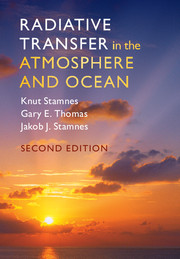Book contents
- Frontmatter
- Contents
- List of Illustrations
- List of Tables
- 1 Basic Properties of Radiation, Atmospheres, and Oceans
- 2 Basic State Variables and the Radiative Transfer Equation
- 3 Basic Scattering Processes
- 4 Absorption by Solid, Aqueous, and Gaseous Media
- 5 Principles of Radiative Transfer
- 6 Formulation of Radiative Transfer Problems
- 7 Approximate Solutions of Prototype Problems
- 8 The Role of Radiation in Climate
- 9 Accurate Numerical Solutions of Prototype Problems
- 10 Shortwave Radiative Transfer in the Atmosphere and Ocean
- Appendix A Nomenclature: Glossary of Symbols
- Appendix B Physical Constants
- Appendix C Ocean Optics Nomenclature
- Appendix D Reflectance and Transmittance at an Interface
- References
- Index
8 - The Role of Radiation in Climate
Published online by Cambridge University Press: 13 July 2017
- Frontmatter
- Contents
- List of Illustrations
- List of Tables
- 1 Basic Properties of Radiation, Atmospheres, and Oceans
- 2 Basic State Variables and the Radiative Transfer Equation
- 3 Basic Scattering Processes
- 4 Absorption by Solid, Aqueous, and Gaseous Media
- 5 Principles of Radiative Transfer
- 6 Formulation of Radiative Transfer Problems
- 7 Approximate Solutions of Prototype Problems
- 8 The Role of Radiation in Climate
- 9 Accurate Numerical Solutions of Prototype Problems
- 10 Shortwave Radiative Transfer in the Atmosphere and Ocean
- Appendix A Nomenclature: Glossary of Symbols
- Appendix B Physical Constants
- Appendix C Ocean Optics Nomenclature
- Appendix D Reflectance and Transmittance at an Interface
- References
- Index
Summary
Introduction
In comparison with shortwave radiative transfer, where nonlocal effects of multiple scattering are important, longwave radiative transfer is simple because the local thermodynamic equilibrium (LTE) source function (the Planck function) is determined strictly by the local temperature and is a smooth, analytic function of wavenumber. On the other hand, it is more complicated, due to the strong dependence of the absorption coefficient on wavenumber, and its dependence on the pressure and temperature along the optical path. In §8.2–8.3 of this chapter, we concentrate on the more practical aspects of computation of atmospheric irradiances and heating rates which are important for the energy flow. IR remote sensing is not considered, as other fine references are available.
In §8.2.1, we consider the basic equations describing monochromatic transfer of radiation in a slab medium, consisting of purely absorbing (nonscattering) molecules. The necessary averaging of the irradiances over wavenumber and angle to yield quantities relevant for the energy flow poses significant computational problems. These problems are of a “mechanical” nature and have not yet been fully overcome, despite the current availability of super fast computers. Various schemes to solve this problem are discussed, including the brute-force line-by-line methods and the narrowband and widebandmodels. The IR warming (cooling) rate is derived in a wideband context, providing a convenient framework for introducing the important cooling-to-space concept. Modern correlated-k techniques are discussed briefly, and some examples of accurate cooling rates are shown.
Atmospheric particles (cloud droplets, ice particles, and aerosols) add richness and complications to the radiative transfer problem. Here, the uncertainties become greater because of the wide ranges of particle types, shapes, distributions, and optical properties. Ultimately, the problem is so complicated that statistical techniques are needed, since clouds and aerosol distributions are generally not available in the detail needed for conventional radiative transfer computations. Furthermore, even if we were capable of measuring the entire microphysical structure of a particle ensemble, it would change with time, and furthermore would strain even today's computational resources. Nevertheless, classical descriptions of clouds in terms of plane-parallel entities embrace a significant portion of the effects of clouds on climate. Thus we confine our attention to these abstractions of nonexistent (but useful) scenarios. Weighting the clear-sky and cloudy scenarios by the cloud “fractional coverage” is a useful device in constructing 1D models of climate that are still useful today, despite its apparently crude nature.
- Type
- Chapter
- Information
- Radiative Transfer in the Atmosphere and Ocean , pp. 278 - 346Publisher: Cambridge University PressPrint publication year: 2017
- 1
- Cited by



